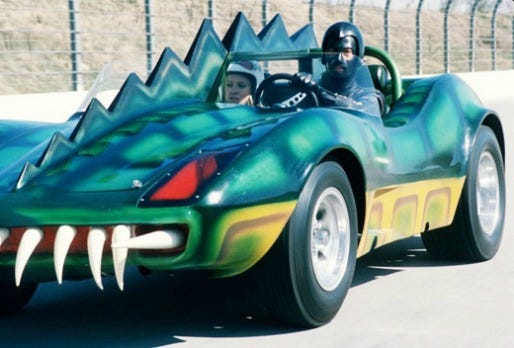Death Race 2000 (1975)

"Death Race 2000" is a movie trying to be schlocky and fun when instead it's just awful and sad.
Over the years, it's acquired a cult status not dissimilar from "The Rocky Horror Picture Show," which came out the same year. I'm not sure if people are lining up for midnight showings of it so they can dress in laugh-out-loud costumes and mimic the dialogue in real time, but maybe in people's living rooms and basements.
The movie exists now mostly as a cheesy artifact that nevertheless influenced later films. It's about a huge annual Transcontinental Road Race in which the main point is for the drivers to kill as many innocent pedestrians as possible. Set in a dystopian future where America has been transformed into an Orwellian nightmare where the people are kept in thrall by an all-powerful leader, the race is a national media phenomenon in which the populace supposedly vents its blood lust by cheering on the gratuitous deaths of others.
Ridiculous television personalities in outlandish outfits act as emcees, gleefully talking up the murderous mayhem to the point we wish they were among those hunted for sport. Of course, many citizens secretly loathe the carnage, and an uprising is growing throughout the land to topple the regime.
Numerous other movies have made use of a similar scenario, starting with "Rollerball," which schlock filmmaker Roger Corman used as the basis for his own down-market ripoff, but with cars. "The Hunger Games" would appear to be the biggest thing influenced by "Death Race 2000," substituting unwilling adolescents for fame-seeking adult drivers.
It was probably a progressive thing in 1975 for two of the five cars to be driven by women, who were just as aggressive behind the wheel — and in bed — as their male counterparts. Every driver has a navigator who rides shotgun and is assumed to be their sexual plaything, including Fred Gandy — later Gopher on TV's "The Love Boat" and a U.S. Congressman — as the squeeze of the Nazi-themed driver, Matilda the Hun (Roberta Collins).
A pre-"Rocky" Sylvester Stallone vamps it up as "Machine-Gun" Joe Viterbo, a gangster type from Chicago whose car sports Tommy guns on the front, along with an absurdly oversized bayonet knife. Curiously, Joe is the one driver who seems to be asexual, showing little interest in the canoodling that goes on between other racing teams. He's also notably sidelined during the en masse nude massage scene that remains the most screencapped thing from the movie, along with the hyper-fast splatter special effects of road kills.
David Carradine plays Frankenstein, the greatest racer ever who's had his body smashed to pieces by his various exploits. He wears an outlandish black costume and helmet that only serve to accentuate his decidedly un-heroic scrawniness. Frankenstein's face is covered/held together by a leather mask that, along with Carradine's long horsey teeth, render him into a somewhat scary countenance.
Of course, it's soon revealed that the mask and the backstory are all a put-on — Frankenstein is a normal, handsome guy underneath with all his limbs intact. Well, except for his right hand, which literally has a grenade recessed into its prosthetic palm ... a "hand grenade," get it? He's the latest in a long line of guys trained to drive and placed inside the black get-up to serve as the nation's anti-heroic, automotive gladiator.
It seems Frankenstein hates the evil President as much as the rebels who are blowing up the drivers in an attempt to foil the race. They are led by Thomasina Paine (Harriet Medin), who has inserted her great-granddaughter, Annie (Simone Griffeth), as Frankenstein's navigator and saboteur. The two play a cat-and-mouse game of one-upmanship that includes a couple of beddings.
Disc jockey Don Steele plays Junior Bruce, the comically upbeat lead race broadcaster, who coos with glee after every kill.
The film is cheap as can be — have you ever heard of a road race with only five contestants? — as was SOP in Corman's assembly line of feature film productions. The cars are beyond silly, not even well-suited to their stated purpose, with outlandish colors, non-functional "weapons" on the grille and all convertibles, so as to ensure any splatted bodies end up right in the faces of the vehicle occupants.
Beyond that, though, think about the race itself: Once a year, deadly cars careen across the country from New York City to Los Angeles, killing everyone they come across (with old people and young'uns carrying extra points). Because it's a national event bigger than the Super Bowl, one would think everyone would know when it's happening and take great pains not to be anywhere on a road that day.
There is some goofy fun to be found in "Death Race 2000," though it's never quite clear if the laughs are intentional or not. I get the sense that director Paul Bartel and screenwriters Robert Thom and Charles B. Griffith started out trying to make a more-or-less serious movie, a parody about America's fascination with cars, sex, violence and television. But at some point, they recognized their budgetary constraints and goofy production design and made a late twisting jump into camp.
The film did well enough to allow Bartel and Carradine to team up a year later for "Cannonball!" (aka "Carquake") about yet another transcontinental road race. Of course, you may have heard of another similarly themed and titled movie from a few years later.
And that's the real legacy of the Corman oeuvre — to spit out movies fast and cheap, where any entertainment value is largely accidental, but inspire other, better filmmakers to copy Hollywood's biggest copycat.
2 Yaps



